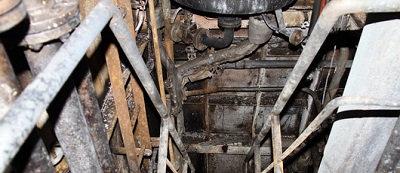Fire Investigation Highlights Disaster Potential
The Danish Maritime Accident Investigation Board has released its findings on the engine room fire on ro-ro Parida, demonstrating how a rather small and well-handled fire can result in the potential for a larger disaster. A minor malfunction in a pressure gauge caused a fire that triggered a loss of propulsion. The onboard conditions interacted with the environmental conditions and created a risk of allision with an offshore platform.
On October 7, 2014, fire broke out on the Danish-flagged Parida while it was underway from Scrabster, United Kingdom, to Antwerp, Belgium. The events can be viewed as three stages: The fire, the engine immobilization and the uncontrolled drift towards the Beatrice Alpha platform. The first stage involved the actual fire in the funnel casing triggered by an unscrewed pressure gauge in the thermal heat-oil system. This allowed oil to enter the area and ignite upon contact with the source of ignition, which was likely the hot surface of the exhaust gas boiler inlet pipe.
The second stage was a consequence of the first; the thermal heat-oil system was substantially damaged by the fire, which caused the activation of main engine slowdown function. Restarting the engine was delayed because of the engine crew’s concerns about re-igniting the fire and uncertainty about the general condition of the engine room systems.
In the third stage, Parida was adrift in the direction of the nearby oil production platform Beatrice Alpha, which was eventually shut down and evacuated. The situation was stabilized as Parida’s drift was halted, and it was taken under tow to the nearby port in Cromarty Firth.
The crew were able to quickly extinguish the fire due to its early discovery and their quick response. The fire was discovered visually before any alarms were received. The funnel casing was fitted with one automatic smoke detector, but this was located in the hydraulic room below the level where the fire developed most intensely. Therefore, the purpose of giving an early warning about a fire in this area was not fulfilled. The smoke would need to develop substantially to fill the space below before activation of the smoke/heat detectors.
 The fire alarm system was not fitted with a log and, therefore, it is uncertain if a fire alarm was activated on the fire control panel on the bridge or whether only a fault message was indicated due to damage to the wiring to the smoke detector caused by the fire. During a larger fire scenario, the absence of a fire detector log is disadvantageous and offers little support in the efforts to keep track of the development and spreading of the fire.
The fire alarm system was not fitted with a log and, therefore, it is uncertain if a fire alarm was activated on the fire control panel on the bridge or whether only a fault message was indicated due to damage to the wiring to the smoke detector caused by the fire. During a larger fire scenario, the absence of a fire detector log is disadvantageous and offers little support in the efforts to keep track of the development and spreading of the fire.
After the discovery of the fire at approximately 1800, the crew initiated firefighting at 1815, and the fire was extinguished at 1835. Under the given circumstances with adverse weather conditions and the distance between the accommodation and the funnel casing, the relatively short response time of 15 minutes was essential for extinguishing the fire. The prompt closing of the ventilation and main engine that would draw air into the engine room was also instrumental in the containment of the fire.
The main fuel to the fire, the thermal heat-oil, was cut off by the thermal heat-oil system because the sensors and their wiring were damaged by the fire causing the circulation pumps to stop. The emergency quick release valves that were designed to enable the oil to be dumped to the drain tank during an emergency malfunctioned as a result of the fire.
The emergency situation that the quick release valves were designed to mitigate thus rendered the valves inoperable. This illustrates well how it can be difficult to design safety features for situations where complexity increases by unexpected interconnections between the accidental events and safety system components, states the report.
The damage and subsequent shutdown of the thermal heat-oil system immobilized the main engine which resulted in the ship drifting uncontrollably. The thermal heat-oil plant and the main engine systems were interconnected in such a way that the continuous operation of the main engine was not possible.
The anchors were deployed and eventually slowed down the drift of Parida and, to some extent, stabilized the situation by removing the immediate threat of allision and provided time for Parida to be assisted by Pacific Champion.
The report is available here.
